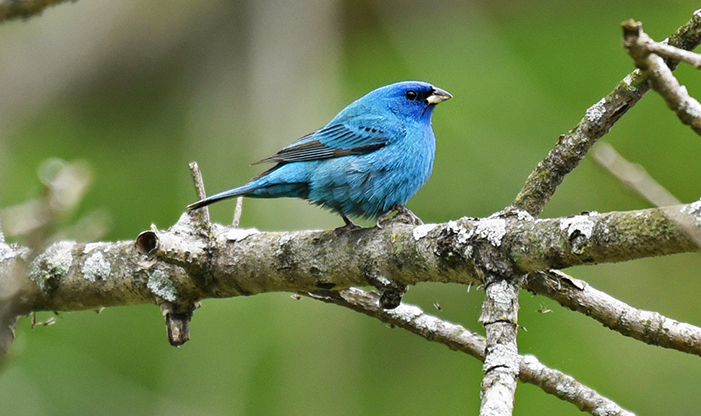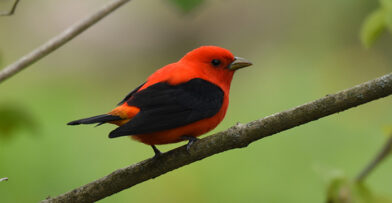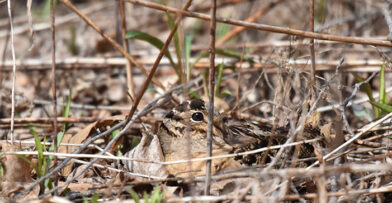Our Bird Profile series highlights a species that is migrating through, breeding, or is a year-round resident of Wisconsin that can be found at Schlitz Audubon or in your backyard.
Name
Indigo Bunting, Passerina cyanea
Basic Description & Appearance
The sparrow-sized, songful Indigo Bunting measures, on average for both sexes, 12-13 cm in length. It weighs about 12-18 grams with a wingspan of 19-22cm. The adult males are a lively looking bright blue color, with dark coloration on their outer wings, and a richer blue on their head. Females and juveniles are brown, with occasional light blue streaking, a lighter colored chest, and a white throat. The birds are stocky, with short tails and short, thick, conical bills.
Vocalization
The male Indigo Bunting is very vocal, singing all day during spring and summer, whistling sharp, clear “chirp” notes that last about two seconds. They can sing 200 songs per hour continuously at dawn and then keep a steady pace of about 60 songs per hour throughout the day. The song’s notes are repeated in pairs and the pattern varies by the bird’s location.
Most males learn their song from neighboring males in the territory where they settle to breed, but not from their fathers. This creates song neighborhoods, and songs learned this way can survive for up to 20 years through many generations within the same locale. The songs are different only a few hundred yards away, and the male Indigo Bunting may change songs when it switches territories.
Males begin singing during spring migration and continue throughout the breeding season. They become quiet after the season is finished, between late June and August. The male’s call is a sharp, one syllable “chip” note voiced in mild distress situations, or a “tink” sound during more intense distress. Females emit calls when mating.
Habitat & Nesting
The Indigo Bunting’s breeding range includes the eastern US, parts of the southwestern US, and parts of southern Canada. They overwinter in southern Mexico, Central America, southern Florida, and parts of the Caribbean. These birds prefer weedy habitat between woods and fields, shrubby swamps, upland old fields, and mesic forests. They live as individuals during breeding season, then gather in flocks of up to 50 birds over winter, living in grasslands, bushy areas, and leafy trees.
During breeding season, female Indigo Buntings arrive from migration a couple of days later than the males and settle on a nest site within two days after choosing a territory. The females then build a nest, which can take from two to eight days to complete. They build it alone, up to one meter from the ground on sites with low, branching vegetation in fields, near the edges of woods, roadsides, and in understory shrub.
The nest is an open cup of soft leaves, coarse grasses, stems, and strips of bark held together with a weaving of spider web and lined with finer materials such as slender grasses, rootlets, and thistle. Clutch size is about three eggs, mostly white with 1% possessing fleck marks. The female Indigo Bunting is inattentive to the nest until last egg is lain, then she will incubate the eggs while the male bird remains uninvolved, except for his chirping when there is an intruder and when the eggs hatch. This bird species has 1-3 broods, and eggs hatch in 11-14 days, depending on the temperature. The hatched birds remain nestlings for 8-14 days.
Diet & Foraging
During the breeding season when it is warm, this bird’s diet consists of mostly spiders and insects, including grasshoppers, caterpillars, and beetles, also eating berries and some seeds. They mainly feed from the ground level to 15 meters, taking the insects from vegetation within the tree canopy. During winter, they eat seeds that have dropped from grasses or on the seed head, as well as berries. The Indigo Bunting forages in trees within its song site, feeding and singing alternatively. The birds eat alone during breeding season and in flocks on its wintering grounds.
When & Where to Find at Schlitz Audubon
This species is found on the edges of our forest habitats, near the ground in brushy areas, peaking from mid-May through the beginning of August.
Other Fun Facts
- Indigo Buntings lack blue pigment. Their wonderfully rich blue color comes from microscopic structures in the feathers that refract and reflect blue light.
- During migration, Indigo Buntings use the stars for guidance, relying on an internal clock that allows them to adjust their angle of orientation to a star.
- Indigo Buntings are long-distance migrants, flying up to 1,200 miles each way between breeding areas in eastern North America and overwintering locations South America.


